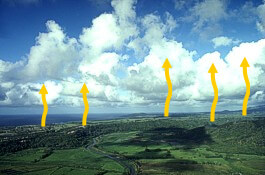The institute's scientists created a model for examining interrelationships between climatic factors, based on formulas that describe relationships between predators and prey S

What is the connection between a soft and airy block of clouds and a herd of deer? A mathematical formula that describes the dynamics of animal populations - such as deer and the prey animals that feed on them - was recently converted into a model that describes the interrelationships between cloud systems, rain and particles floating in the atmosphere called aerosols. This model may help, among other things, in understanding how human-made aerosols affect rain patterns.
Clouds are known to make a significant contribution to the climate system, and especially marine stratocumulus clouds, which cover large areas over subtropical oceans, cooling the atmosphere by returning part of the solar radiation to space. Dr. Ilan Koren from the Department of Environmental Sciences and Energy Research in the Faculty of Chemistry at the Weizmann Institute of Science and Dr. Graham Feingold from the NOAA Earth Research Laboratory in Colorado found that formulas used in models of predator-prey cycles in the living world are also suitable for cloud-rain cycles: just like predator populations And are devoured which grow and shrink at the expense of one another, so also the rain empties the clouds, and they return and are filled when the rain ends. In addition, similar to how the availability of grass affects the size of the herd, so the relative availability of aerosols - the "seeds" that form the clouds when water droplets condense around them - affects the shapes of the clouds. A greater supply of particles in the air results in the production of more droplets, but these droplets are smaller, so they remain high up as clouds, instead of falling as rain.
In their previous research, Dr. Feingold and Dr. Koren looked closely at marine stratocumulus systems, and discovered fluctuations in cloud cells with vertical air flow. In the current study, the scientists returned to the collected data, and looked at it with a "supervision", with the aim of trying to check if a general formula could reveal something about these systems. Using just three formulas, they developed a model that shows that the dynamics of clouds and rain mimic three known predator-prey relationship patterns. Like lions and deer, the clouds and the rain can oscillate in a timed manner, with the "predatory" rain cycle following the development of the clouds and slightly lagging behind it. Another possibility is reaching a sort of equilibrium state, where the rate of cloud renewal is the same as the rate at which the rain reduces them. A third possibility is chaos - the collapse that occurs when the predator population "overflows", which is equivalent to a situation where heavy rain destroys the cloud system.
According to the model, a change in the amount of aerosols in the system may cause sharp transitions between the three states. The model shows that there are two scenarios for the formation of conditions for stable patterns, and that they are found at both ends of the scale of the amount of aerosols. In the first scenario, low aerosol levels lead to the formation of clouds whose development depends to a significant extent on the aerosol concentrations. In the second scenario, high levels of aerosols create a saturation state. In this situation, the clouds depend on the initial environmental conditions only.
"Using this systemic approach," says Dr. Koren, "may open a new window through which we can better see and understand the complex relationships between clouds, rain and aerosols during the formation of the systems. The ability to look at the big picture will help us understand how the change in aerosol concentrations - which are created as a result of human activity - cause changes in climate patterns."
